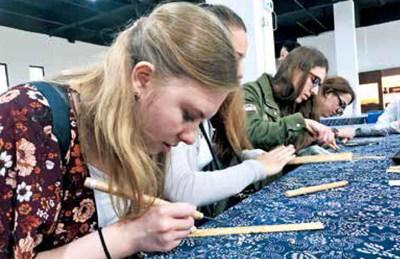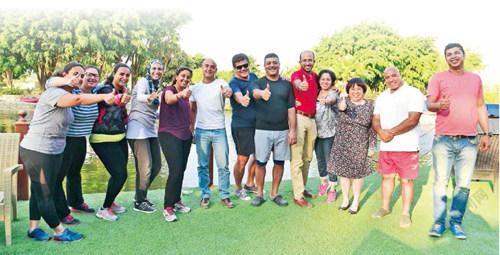超越传统发展援助 增进民心相通
2019-09-10
“一帶一路”作为全球治理创新模式的积极探索,非常注重沿线国家渴望经济发展和改善民生的实际诉求。中国的实践经验表明,以教育促就业、以产业促发展,才能真正帮助受援国摆脱贫困,实现经济社会可持续发展。“一带一路”倡议实施5年多以来,大量惠民工程已在沿线国家产生积极社会效果,如中国援建的穆桑泽职业技术学校成为卢旺达北方省最大的职业技术培训中心;云南民族大学与腾冲共建的澜湄职业教育基地,为湄公河五国培养了上万名专业技术人才,有效提升了当地的劳动生产力水平。
此外,中国投资企业注重本地化经营,许多基建项目本地化用工比例达到60%,部分制造业企业的比例高达90%,极大促进了所在国就业。中巴经济走廊早期收获项目已创造3.8万个工作岗位,其中75%以上为当地就业;泰中罗勇工业园已吸引105家中国企业入驻,解决当地就业3万多人;西哈努克港经济特区入驻企业125家,解决当地就业2万多人。截至2018年,“一带一路”已经为沿线国家创造了数十万个就业机会,创造了几十亿美元的税收,为沿线国家的经济增长和民生改善做出了显著贡献。
促进经济发展、增进人民福祉是“一带一路”沿线国家当前的首要任务,更是中国同沿线国家的利益交汇点。“一带一路”倡议是建立在各方平等互利基础上的新型合作平台,不存在任何附加条件和从属关系,更能带动当地民众参与,更容易获得当地民众支持。“一带一路”倡议下各国的互利合作,打破了发达国家传统资金援助的“输血模式”,积极探索以培育发展中国家内生发展动力的“造血模式”,超越了传统的北南发展援助,真正做到了“授人以渔”,是经济全球化背景下南南发展合作的新典范。
——北京大学新结构经济学研究院、北京大学国家发瓞研究院 赵祚翔

参与建设蒙内铁路的肯尼亚女工程师

来自“一带一路”沿线国家的留学生体验徽州竹雕(本版图片/新华社 供图)
As an active effort in exploring a new global governance model, the Belt and Road InitiatiVe attaches greatImportance to the practical needs of the Belt and Road countries for economic development and better livelihoodof their peoples. China has learned from its own practice and experience that only education-based employmentand industry-based development can help recipient countries to eliminate poverty and realize sustainableeconomic and social progress.Over the five-plus years since the Initiative was proposed,a great number ofpeople-oriented projects have delivered tangible social benefits to the Belt and Road countries: The MusanzeIntegrated Polytechnic Regional Colleague built by China for Rwanda has grown into the bjggest professionaltrainino center inthe Norhem Province; the Lancang-Mekong Vocational Education Base, jointly built byYunnan Xinzu University and Tengchong County, has trained thousands of technical personnel for Myanmar,Laos,Thailand,Vietnam and Cambodia, effectively enhancing local labor productivity.
What's more, Chinese investors value localized operation. Local labors account for 60% in the infrastructureconstruction field and up to 90% in the manufacturing industry in some cases,greatly boosting the employmentof the host countries. Earlv-harvest projects of the China-Pakistam Economic Corridor have created 38,000jobs, more than 75% held by local people; in theThai-Chinese Rayong Industrial Zone. 105 Chineseenterprises have settled down, offering jobs tomore than 30,000 locals; the Sihanoukville SpecialEconomic Zone (SSEZ) is home t0 125 enterprises,employing more than 20,000 local labors. As of theend of 2018, the Belt and Road Initiative had offeredhundreds of thousands of jobs and generated severalbillion U.S. dollars of tax revenue, making significantcontributions to the economic growth and people'slivelihood of the Belt and Road countries.
Economic growth and better livelihood arethe priorities of Belt and Road countries, and theconverging interests between China and thesecountries. The Initiative is a new cooperation platformbased on the equality and mutual benefit of all parties, with no additional conditions or subordinate relationship.That is why it has encouraged the participation of local people and won their support. Under the framework ofthe Initiative, cooperation among countries is mutually beneficial and has tumed from the conventional "bloodtransfusion" model that developed countries provide capital aid to developing countries to "blood generation"model where China explores ways to help developing countries develop their own endogenous growth driver.This "teach a man to fish" cooperation model has transcended the traditional North-South development aid andset up a new model of South-South cooperation against the backdrop of economic globalization.
——Zhao Zuoxiang, Institute of New Structural Economics at Peking University, National School of
Development at Peking University
“一帶一路”不仅是经济全球化、经济发展的路线图,也是一个文化发展的路线图。五通当中最重要的是民心相通,如果没有民心相通,彼此之间没有了解,那么其他的通都无法谈起,所以文化必须先行。我们必须强调文化自信。文化自信就是中国特色社会主义文化自信,这种文化源自于中华五千年文明发展史当中所培育的中华优秀传统文化,党领导人民在和平建设改革当中所创造的革命文化和社会主义先进文化,植根于中国特色社会主义伟大实践。
——中国文化软实力研究中心主任、中央马克思主义理论研究和建设工程首席专家 张国柞

The Belt and Road Initiative is not onlv a roadmap for economic globalization and development, but also aroadmap for cultural progress. People-to people bonds top among "policy coordination, facilities connectivitv,unimpeded trade, financial integration, and people-to-people bond", without which mutual understanding isimpossible and the other four aspects are groundless. That is whv we must give top priority to culture. We mustemphasize cultural confidence. Cultural confidence means that we should be confident in the socialist culturewith Chinese characteristics. The socialist culture originates from the fine traditional Chinese culture nurturedthrough the five thousand years of Chinese civilization, the revolutionary culture and advanced socialist culturecreated in Chinese people's peaceful construction and reform led by the CPC, and is rooted ul the great practiceof socialism with Chinese characteristics.
——Zhang Guozuo, Director of China's Cultural Soft Power Research Center and chief expert of Central
Marxist Theory Research and Construction Project
共建“一帶一路”是不同民族、不同国家、不同政治制度、不同文明、不同宗教信仰、不同地域、不同经济发展水平国家的大合作,没有一定的文化交流、文化认同、文化价值的包容,是不可能做到民心相通的,也不可能有广泛的社会共识。
——清华大学新闻传播学院院长、原新闻出版总署署长 柳斌杰
The co-building of the Belt and Road is a great cooperation project among different ethnic groups, nations,political systems, civilizations, religions, regions, and countries of different economic growth levels. Therefore,cultural communications and recognition, and inclusiveness of cultural values are essential to people-to-peoplebonds and extensive social consensus.
——Liu Binjie, Dean of the School of Journalism and Communication, Tsinghua University, former
Minister of the General Administration of Press and Publication
“一带一路”不仅注重经济合作等方面的“硬联通”,更注重民心共振、温暖人心的“软联通”。近6年来,民心相通建设为共建“一带一路”奠定了坚实的民意基础。下一步,中国与合作伙伴国有必要加强民心相通建设的整体布局,突出工作重点,打造活动品牌,创新合作形式,拓展人文交流的宽度和深度,共建“一带一路”精神家园。
——中共中央对外联络部当代世界研究中心主任、“—带一路”智库合作联盟秘书长 金鑫
Not only focusing on "hard connectivity" such as economic cooperation, the Belt and Road Initiative alsoattaches importance to "soft connectivity" like people-to-people exchanges. Over nearlv six years, the programof people-to-people bonds has laid a solid foundation of popular will for the Initiative. Going forward, it isnecessary for China and its partners to intensify the overall layout of people-to-people bonds, highlight workingpriorities, shape activity brands, create new forms of cooperation, and broaden and deepen cultural exchanges, toco-build the spiritual home for the Initiative.——Jin Xin, Director of China Center for Contemporarv World Studies of the International Department
of the CPC Central Committee and Secretarv General of the Belt and Road International Think Tank
Cooperation Alliance
中国企业在“一带一路”沿线开展项目建设时,保护环境是必须注意的重要问题。同时,企业还应注意履行社会责任,加强与当地政府、企业、民众等各界的沟通与联系,了解和尊重当地文化、宗教和风俗习惯;尽可能多地使用当地人员,为当地创造更多的就业机会;积极为当地的教育、卫生、科技、体育、社区发展事业作贡献,使当地人民得到实实在在的收益,做好共建“一带一路”中的形象大使。
——北京师范大学“一带一路”研究院院长 胡必亮
For Chinese enterprises engaging in project construction along the Belt and Road, it is important to protectthe environment. Meanwhile, they should fulfill their social responsibilities, strengthen communications andcontacts with local oovemments, enterprises, people,and other circles of society, and leam and respect localcultures, religions, and customs; employ local people as manv as possible and create more jobs for localcommunities; make active efforts to contribute to local education, health, technology, sports, and communitydevelopment, and bring tangible benefits for local communities, building the image of China in the Belt andRoad countries.
——Hu Biliang, Dean of the "Belt and Road" Research Institute, Beijing Normal University
